
A fisherman at Bangtao, Phuket, circa 1962. Photo by Saengjun Limlohakul.
I missed the exhibition of Thai photographs on which this excellent book is based. They were on show at the Bangkok University Gallery in September 2015. The accompanying catalogue is the work of celebrated Thai photographer and owner of Kathmandu Photo Gallery on Pan Road off Silom, Manit Sriwanichpoom. Rediscovering Forgotten Thai Masters of Photography comprises a selection from seven neglected photographers, all male, quite a few of Chinese origin, operating in Thailand mostly during the 1950s and ’60s. Many of the reproductions are from glass negatives or vintage prints, the original negatives having been lost or wasted away. In the case of the monk photographer Buddhadasa Bhikkhu, this decay both of print and negative has been incorporated as an aspect of the work: all things must pass. Each of the seven photographers gets a mini-essay by Manit, introducing the geographical, technical and social contexts of their work, but also the circumstances of the photographer’s re-discovery. This re-discovery is in itself fascinating because it points to the fragility of the photographic art in a tropical climate, but also to questions of historiography, of whose culture to preserve. In a culture which sees things very much in a hierarchy from the top down, it is good to pay attention to the grass roots.

S. H. Lim’s portrait of Phusadee Anukkhamontri in Bong girl mode, circa 1967
All over Bangkok and throughout the Kingdom the visitor will see photographs of His Majesty the King with a camera. He has been a recorder of his realm’s many changes since the Second World War. One day a curated selection of his photographs will see the light of day. Photography in Thailand, as so much else, has until recently followed the royal narrative. Last year the National Gallery in Bangkok hosted an exhibition of John Thomson’s photographs of Siam dating from 1865-66, taken under the reign of King Mongkut. The court of King Chulalongkorn at the end of the nineteenth century disseminated the recording art. Photography in Thailand, therefore, is already a century and a half old. But how much of this filtered down? And how much has been lost by neglect and the ravages of climate?

H.M. the King of Thailand’s custom-made gold plated Leica.
What is refreshing about Manit Sriwanichpoom’s approach is that it is provincial in the best sense of the term, and varied in scope. His photographers hail from Phuket, Phimai and Bangkok, emerging from provincial Chinese-Thai photography studios, from a shed in the garden, from the proverbial drawer. One is a minor princeling, another a revered monk, still others were working in photo-journalism and the lubricious world of post-war nudity. It’s a mixed bag, but an interesting bag from the point of view of Thai sociology.
Sociology is all over this book. Tracking down photographer Liang Ewe (1911-1992), Mani mentions Phuket’s tin mining industry:
… the collection of photographs from Liang Ewe’s working lifetime (1932-1987) has now become a cultural trove of immeasurable value, both as treasures of art and as social document. This period coincided with the tin-mining boom reaching its height and then declining, in parallel with Liang Ewe’s retirement as Phuket closed its last mines in 1992-93.
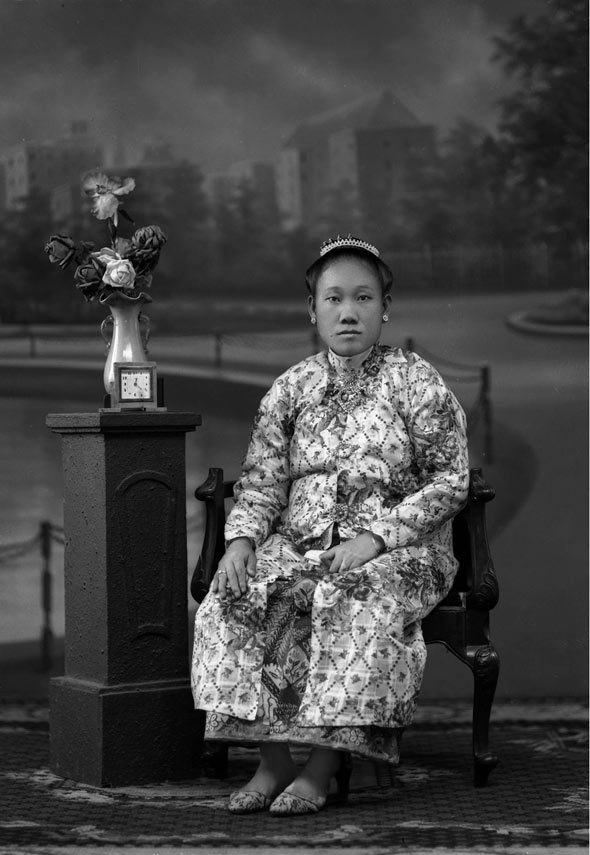
Liang Ewe, Phuket woman in Baba-Peranakan style clothing, glass negative, 1959.
Liang Ewe was born Aree Khorchareon on Phuket, of Chinese Hokkian parents, and educated in Penang. The name change and the mixed cultural heritage point to the wonderful peninsular diversity of this book and of Phuket itself. Self-taught, he became a portrait photographer, therefore capturing the class aspirations of his sitters. “Local girls during the tin boom,” could almost be a song lyric. Ewe’s portraits show a diverse cross-section of Phuket society:
If the photo showed a man wearing a Chinese tunic, a Muslim headdress or a Sikh’s turban it does not mean he wasn’t a Phuket native; the island had seen a thriving mining industry for over a hundred years, and seekers of its fortunes have not only been local Thai people but those of various nationalities.
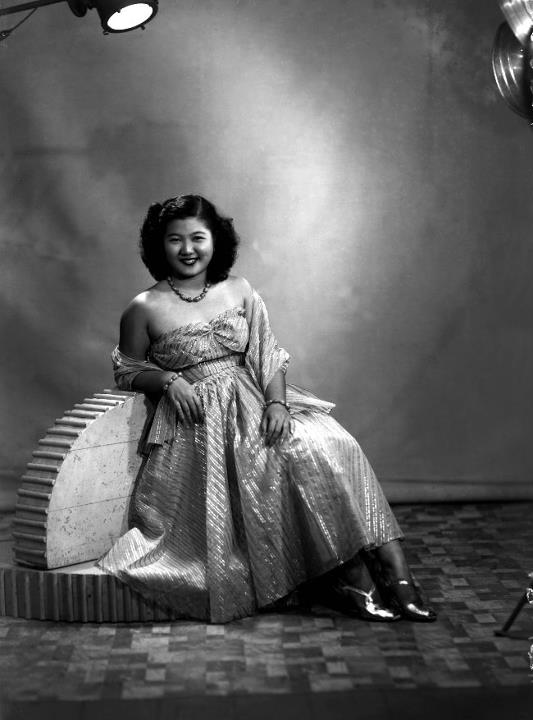
Liang Ewe, Phuket woman, 1955.
Ewe’s abandoned studio is still there in Phuket, “worn down by the tide of time,” as Manip puts it. He moots the idea of preserving the space for posterity as a “living museum”. Documenting the trove of photos stretching back decades, waiting to be brought to light, is a labour of love. Meanwhile, the glass negatives are beginning to be scattered and the studio is gathering dust. Unless there is grassroots interest and government or private intervention, this aspect of Phuket’s artistic and cultural heritage will fritter away in the tropical sun.
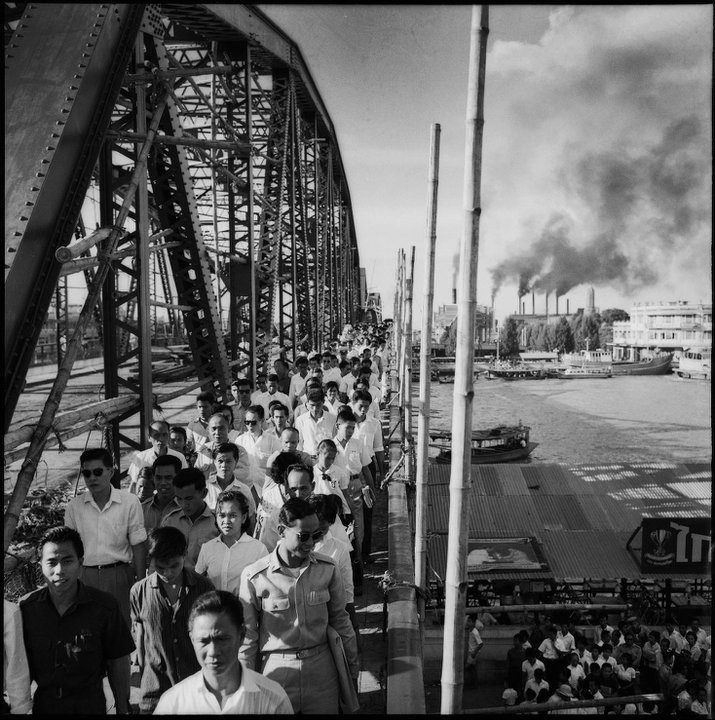
Photo by Rong Wong-Savun, The Memorial Bridge, circa 1958, Bangkok.
One of the discoveries for me in this book is the work of Rong Wong-Savun, whose eye, as MR Kukrit Pramoj said, “takes photographs with a Westerner’s mind”. In the above photograph of the Memorial Bridge it is the density of incident, light and shade which is appealing. The upward thrust of the bridge, the bamboo poles and the smoking chimneys on the Thonburi side, seems to express the crisp preparedness of the pedestrians. It reminds me of T.S. Eliot’s line about Londoners crossing Westminster Bridge: “Who would have thought that death had undone so many?” In 1957-8 Thailand was in the throes of yet another dictatorship. Field Marshal Phibunsongkhram’s time in office had come to an end and Field Marshal Sarit Thanarat was waiting in the wings with the usual musical chairs of goons, politicians and ex-military filling in the gaps. It is an optimistic picture from this unassuming photographer who seemed to have learned not to look at things straight on, but from an angle.
Only a few people knew that before my father became an author, he was a professional photographer who dreamt of becoming an architect. Although some time would pass until he became a writer, he would always have his camera beside him every time he was on a trip. He would bring the camera with him wherever he went, taking photos, together with writing in some journals. This set of photographs is pictures of Rama I Bridge after a renovation in 1957. I believe my father intended to capture the atmosphere of people who had gathered to see the bridge after it had been restored. I cannot assume what my father really wanted to communicate from these pictures but I do believe these can convey the story of an event from the past to the present. The photos act as a ‘bridge’, connecting both eras for today’s Thai people to understand the past of this big city called ‘Bangkok’. (Saroengrong Wong-Savun, the photographer’s son)
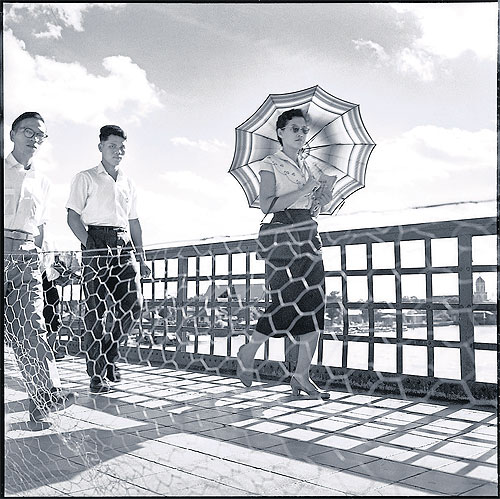
The Bridge, circa 1958, by Rong Wong-Savun
Long Wong-Savun was educated, as his 2009 obituary in The Guardian put it, “at the elite Triam Udom Suksa school in Bangkok. Despite demonstrating literary promise, he was expelled after an altercation with a teacher and was obliged to seek employment, including spells as a ship’s helmsman, log yard supervisor and model.” His photographic work was overtaken by his work as a writer, and he became national artist in the field of literature in 1995. His chiding critique of Thai society often took the form of satire and noir, and he was both prolific and a cult figure on the literary scene. The Guardian obituary again:
In the early 1960s – against a backdrop of repressive military rule, rapid economic expansion under the umbrella of American anti-communist influence, and profound social transformation, including urbanisation and the first signs of the emergence of an educated middle class – he produced several ground-breaking novels. Sanim Soi (1961) addressed prostitution, a particularly sensitive area associated with poverty and neglect. Concealed beneath an artificial edifice of public morality are the “paid women” who service the sexual needs of society. In the days before Aids, this was the first Thai book to address sexually transmitted infection. Bang Lampoo Square (1963), named after the inner-city Bangkok district, was a semi-autobiographical account of a school dropout living among petty criminals on society’s edge.
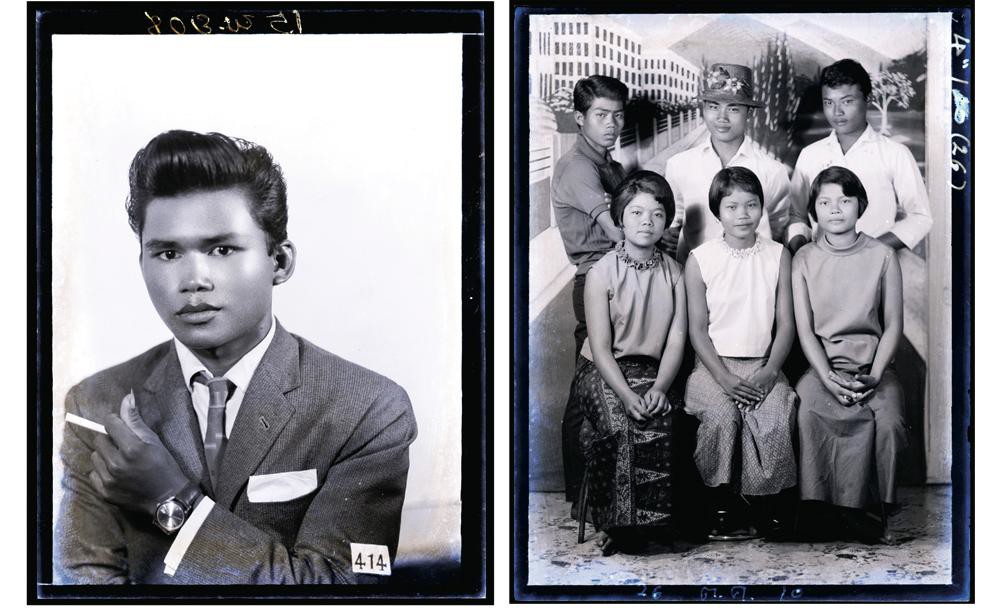
Pornsak Sakdaenprai’s country music-style portraits from 1965.
Pornsak Sakdaenprai is from Pimai, a northeastern town with the remains of a famous Khmer temple compound testifying to its position between two cultures: Khmer and Thai. His sitters have the lick and spittle of country and western stars, the negatives touched up to give them an upwardly-mobile sheen. Motorcycles, cigarette, a cowboy slouch and a Brylcreemed quiff are the appurtenances of this luk thung look. Luk thung is Thai country music. Like Liang Ewe, Pornsak originally had a Chinese name. He started taking photos at fourteen and selling them to passing tourists visiting the Phimai temple.
I opened the studio in 1959 when I was twenty-one by borrowing 20,000 Baht from my aunt. There was no electricity here then, so at first we made prints from sunlight. We’d use a mirror to reflect light into a drawer (in which the paper is affixed, to be pulled in and out of the desk to control exposure]… The chemicals for the developing process came from the Snow White shop in Korat. When i didn’t understand something I would go and ask them.
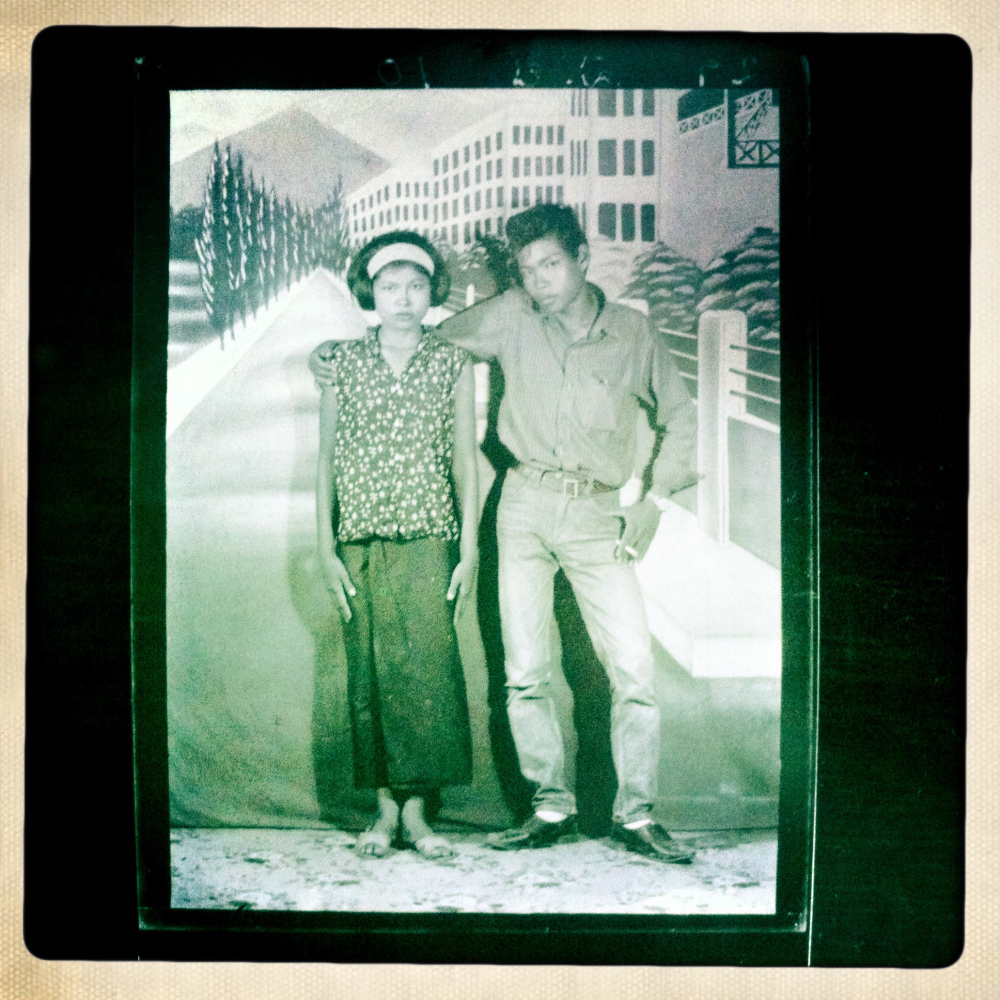
Slouching towards Korat: Pornsak Sakdaenprai’s country people in 1965
He worked with Agfa Gevaert glass plates, employed Vietnamese technicians to do the retouching, and posed his country folk in front of a Western-style painted city backdrop. The glossy results have a vintage kitsch quality which is very appealing.
Most of the customers who came in those days worked in the fields; their faces were dark, their skin burnt by the sun. We had to help make them look good. For example, some people didn’t have eyebrows and eyelashes, so we added them. If we didn’t do anything they wouldn’t be presentable.
Rediscovering Forgotten Thai Masters of Photography is a fine selection of the work of these neglected photographers and of the fleeting time they captured. The book is available in Bangkok bookshops and at Kathmandu Photo Gallery in Bangkok.
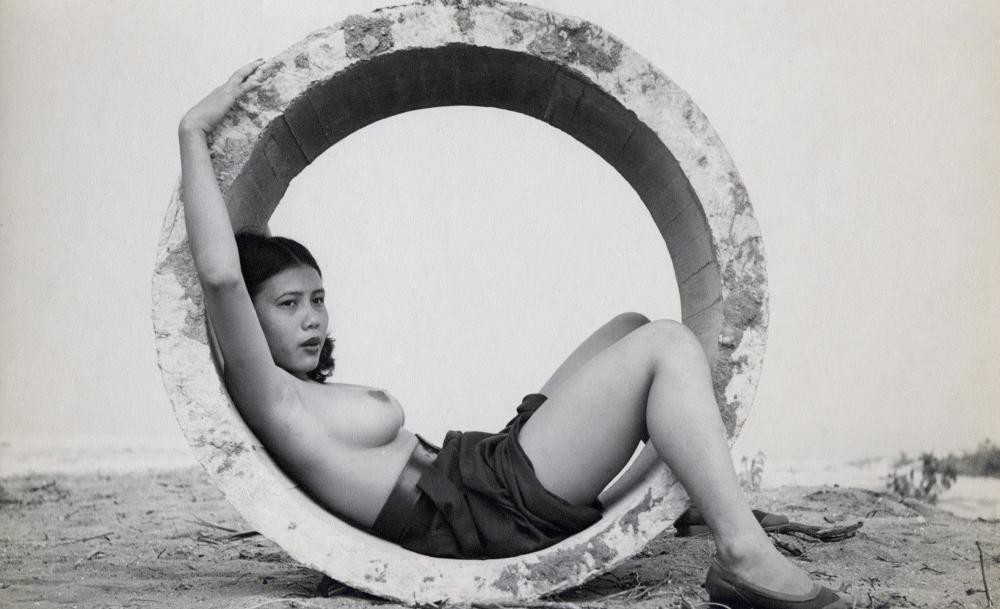
Photo by Mom Luang Toy Xoomsai (1906-1961), circa 1946-1961.

